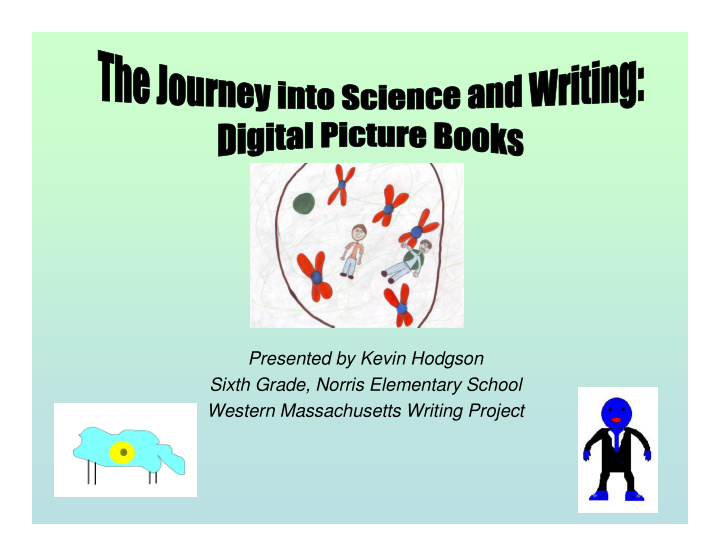



Presented by Kevin Hodgson Sixth Grade, Norris Elementary School Western Massachusetts Writing Project
������������ � ��������� � �������������� � ����������� � �������������� � ���������� � ���������� � �������� ����������� � �������������
��������� • Connecting science with writing makes material and learning more accessible and interconnected for students • Integrating technology in a meaningful way • Writing and publishing a book is for a very authentic audience • Creating original artwork puts students in charge • Allowing student-directed learning process for exploration and understanding
����������������� • Media Specialist/Librarian Pati Mari works with students on understanding the design and intent of picture books • Art teacher Leslie DiCurcio explains how art is used as a device for storytelling in picture books • Science teacher Lisa Rice provides foundation of basic math concepts • Writing/technology teacher Kevin Hodgson introduces the compositional elements of planning, drafting and creating a book PS – students write the stories!
�������� • Week One : Come up with a concept and target a specific audience. Develop a storyboard with sketch drawings and frame story ideas. Invite in an author/illustrator to talk about the process. • Week Two : Write a rough draft of the story in Microsoft Word and proofread. Begin work on the computers. • Week Three : Work towards completion of pictures and words; Consider adding multimedia elements such as audio narration, slide and image transitions, etc. Classmates read and critique the developing picture books, providing authentic input for revisions. • Week Four : Invite students from younger grades to tour the classroom in round robin format, reading and/or listening to stories and asking questions of writers; reflect on process and experience. • Week Five and beyond : Publish the picture books to the Sixth Grade Weblog (for families) and print out two copies of every book (one for writers and one for school library). Teacher grades projects. Student Project Overview Handout
����������� Writing Technology • Story development • Mini-lessons on Powerpoint • Use of art to complement writing • Creating art on the computer • The use of “the journey” as a plot • Use of animation device • Adding audio • Peer reviewing components • Adding video components
����������������� �� • From Book • To Television • To Computer
�������� ����!���� ��������
View the picture book
������� ����������
��������� �����������
"������������������������#$���� "�������������!% • Video Introductions by Authors • Hyper-linking outside of books • Audience reconfiguring the story (re-sequencing frames or mixing two or more stories together) • Audience recording their own reactions to the story with audio • “Instant editing”
Why this book is digital … • “I consider my book to be truly digital because some of the best parts (hyperlinks, movement, etc) are not part of the paper book and therefore, the paper book isn’t really complete at all.” – Mika C. • “Digital and traditional books are different because you can make things move (in a digital book) and it can have such things as sound, graphics and movement of any kind.” – Alex T.
Surveying Student Perceptions
What happens when you flatten a digital book? • You lose sound • You lose moving images • You lose some sequencing of ideas • You lose the interaction with audience
�����������&������' ���������� �������� • Younger grades visit and watch “books” on the computers, ask questions • Publish an electronic version to our Weblog site for families to view as a slide shows • Print out paper copies for both home and for Norris library • Copies sent home on flash drives and CDs
����������������������������� �����������(�������)�*�#+� • GENERAL STANDARD 20: Consideration of Audience and Purpose Students will write for different audiences and purposes • GENERAL STANDARD 22: Standard English Conventions Students will use knowledge of standard English conventions in their writing, revising, and editing • GENERAL STANDARD 25: Evaluating Writing and Presentations* (Continued) Students will develop and use appropriate rhetorical, logical, and stylistic criteria for assessing final versions of their compositions or research projects before presenting them to varied audiences • GENERAL STANDARD 27: Media Production* Students will design and create coherent media productions (audio, video, television, multimedia, Internet, emerging technologies) with a clear controlling idea, adequate detail, and appropriate consideration of audience, purpose, and medium
����������������������������� �����������(�������)�*� �������� , �����!�������- Broad Concept : All living things are composed of cells. Life processes in a cell are based on molecular interactions. General Standard 2.1 Relate cell parts/organelles to their functions.* General Standard 2.10 Describe and compare the processes of mitosis and meiosis, and their role in the cell cycle.
.������������/�����������!������ ��������������0����������% 1����������!2���������' ��������������������������* �������0���������������� �3�������������)�!����������������� �3������������������������������� �#�������������������
����#��
Recommend
More recommend